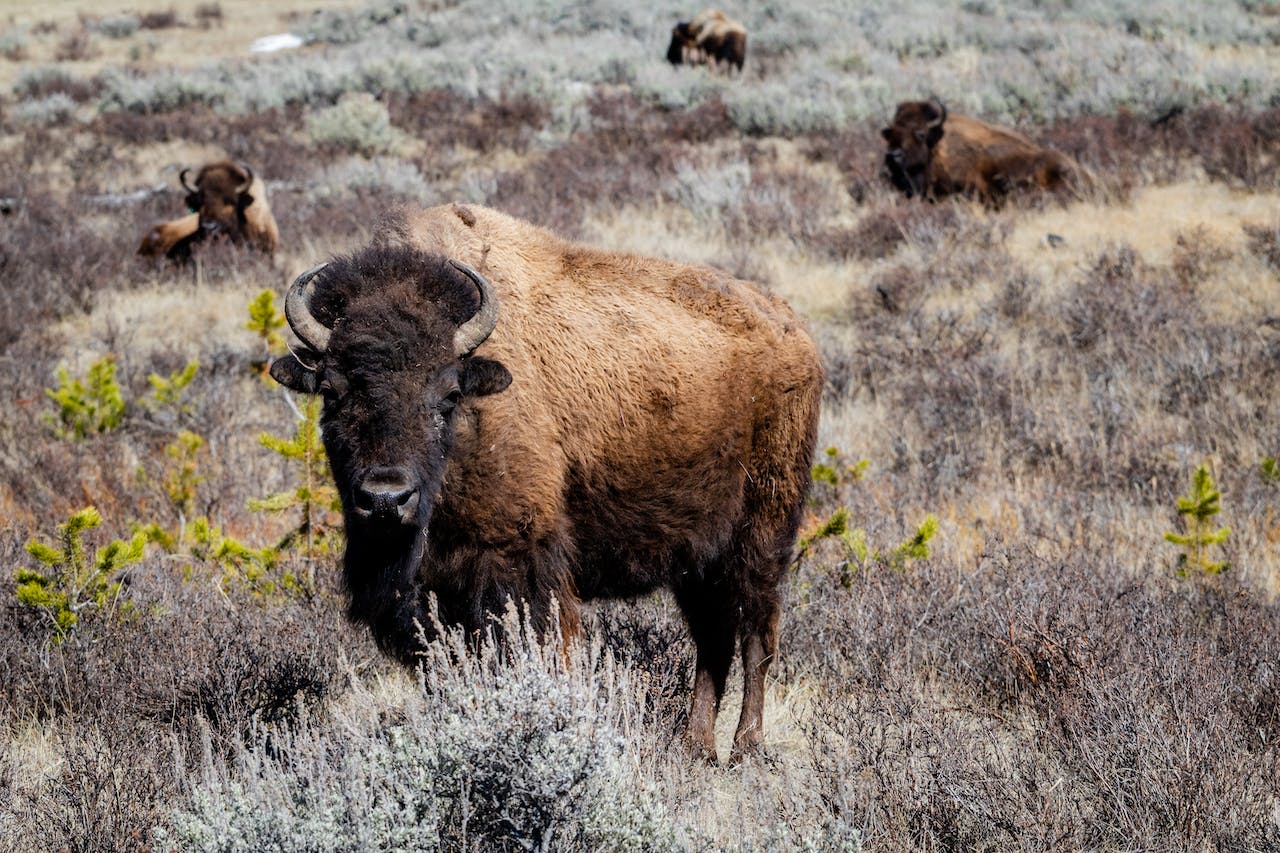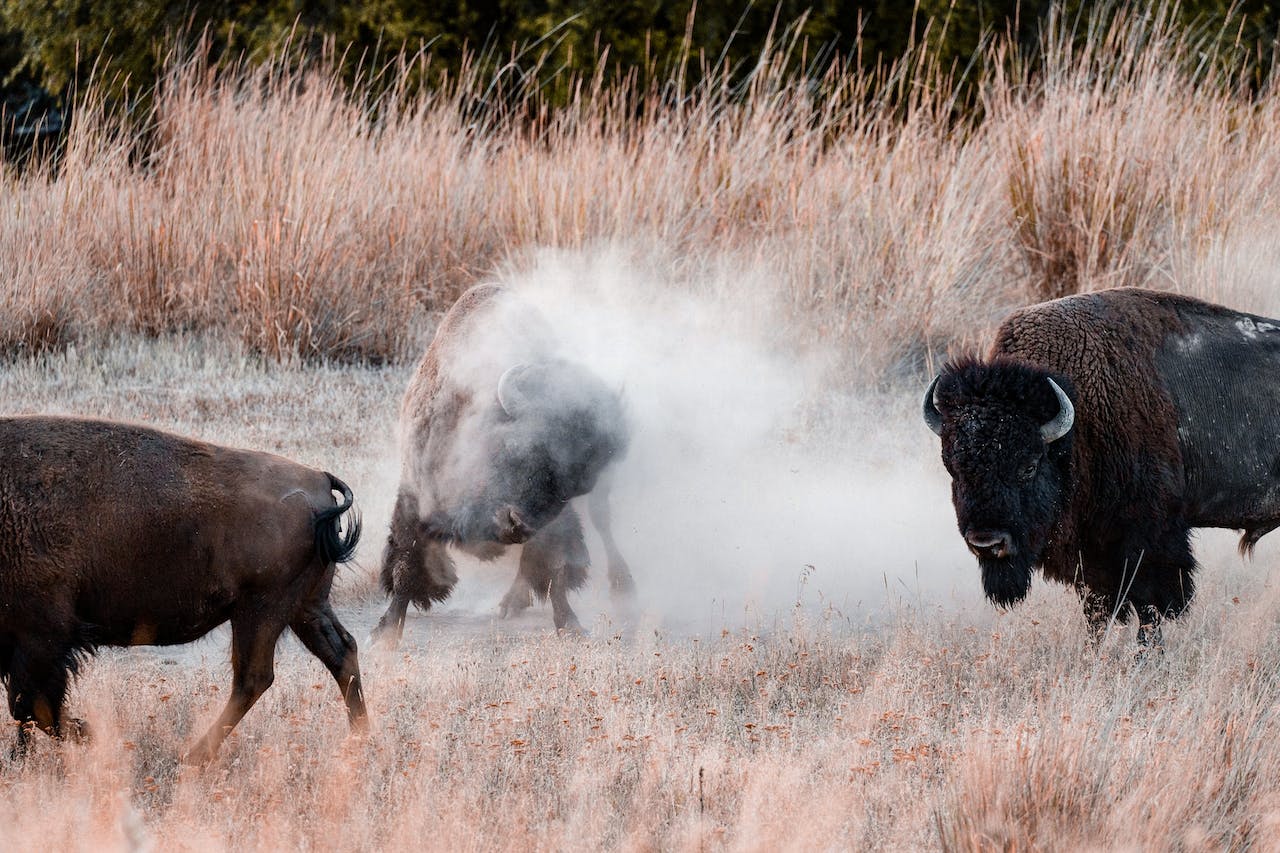Where To See Buffalo In Kansas
Embarking on a journey to discover "where to see buffalo in Kansas" opens the door to a world where history, nature, and the majesty of these iconic creatures converge. If you're interested in experiencing the beauty and majesty of these creatures up close, here are some of the best places to see buffalo in Kansas.
Author:Mia ThompsonReviewer:Calvin PenwellNov 16, 202322.1K Shares325.1K Views

Kansas, known for its expansive prairies and rich agricultural heritage, is also home to one of North America's most iconic creatures - the American buffalo. These magnificent creatures once roamed the plains in vast numbers, and today, efforts have been made to preserve and protect their populations.
Embarking on a journey to discover "where to see buffalo in Kansas" opens the door to a world where history, nature, and the majesty of these iconic creatures converge. If you're interested in experiencing the beauty and majesty of these creatures up close, here are some of the best places to see buffalo in Kansas.
History Of Where To See Buffalo In Kansas
The history of buffalo in Kansas is intertwined with the broader narrative of American expansion and the changing landscape of the Great Plains. Here is a brief overview:
Pre-Settlement Era
Prior to European settlement, the region now known as Kansas was part of the vast North American prairie ecosystem. Bison, commonly referred to as buffalo, were a central and abundant species in this environment. Estimates suggest that millions of bison roamed the plains, forming a crucial component of the Plains Indians' way of life.
Impact Of European Settlement
With the westward expansion of European settlers in the 19th century, the buffalo population faced rapid decline. Factors such as unregulated hunting, habitat loss due to agricultural development, and the construction of railroads contributed to their dwindling numbers.
The Rise Of Commercial Bison Hunting
In the mid-1800s, a market for buffalo hides emerged, driven by demand for leather goods, particularly in the Eastern United States. Professional hunters, known as "buffalo runners," played a significant role in the mass slaughter of buffalo. Their methods, including the use of rapid-fire rifles, contributed to the decimation of buffalo herds.
Near Extinction And Conservation Efforts
By the late 1800s, the buffalo population in Kansas, like much of the American West, had been dramatically reduced. Concern for the species' survival led to early conservation efforts. Organizations and individuals recognized the ecological importance of the buffalo and worked to establish protected areas and reserves.
Tallgrass Prairie Restoration
In the 20th century, efforts to restore and preserve the Tallgrass Prairie ecosystem, of which buffalo are a keystone species, gained momentum. Initiatives such as the establishment of the Tallgrass Prairie National Preserve in Kansas aimed to protect and restore this unique habitat.
Private Bison Ranching
In recent decades, private bison ranches have emerged as essential contributors to buffalo conservation. Many ranches across Kansas now serve as stewards for these animals, working to maintain healthy herds and contributing to genetic diversity.
Present-Day Status
Today, the buffalo population in Kansas has rebounded from the brink of extinction thanks to concerted conservation efforts. While they no longer roam the plains in the millions, buffalo herds in preserves, refuges, and private ranches across the state provide opportunities for people to witness and appreciate these iconic creatures in their natural habitat.
Significance Of Buffalo In Kansas
The significance of buffalo in Kansas extends far beyond their role as iconic creatures of the plains. These majestic animals have played a pivotal role in shaping the state's history, culture, and ecosystem.
Cultural Significance
For centuries, the buffalo held profound cultural importance for Native American tribes in Kansas. It was a source of sustenance, providing meat, hides for clothing and shelter, and bones for tools. The buffalo's spiritual significance was also deeply ingrained in tribal ceremonies, traditions, and folklore.
The arrival of European settlers drastically altered the relationship between humans and buffalo. The rapid depletion of buffalo herds for commercial purposes, such as hides and meat, led to a significant decline in their population. This shift had profound implications for both Native American communities and the emerging settler society.
Ecological Impact
In ecological terms, the buffalo, or American bison, is considered a keystone species. Their grazing behaviorinfluenced the composition and structure of the prairie ecosystem. By trampling and grazing on grasses, they helped to maintain the health and vitality of the prairie, which, in turn, supported a diverse range of other species.
With their near extinction in the late 19th century, the prairie ecosystem faced disruption. The absence of buffalo led to changes in vegetation and impacted the dynamics of other wildlife species. Efforts to reintroduce buffalo to their native habitats in Kansas have aimed to restore this critical ecological balance.
Conservation And Preservation:
The conservation of buffalo in Kansas is a testament to the state's commitment to preserving its natural heritage. Establishments like the Tallgrass Prairie National Preserve and private buffalo ranches play a crucial role in safeguarding these creatures. Through these efforts, Kansas ensures that future generations can witness the splendor of buffalo in their native environment.
Educational Opportunities
The presence of buffalo in Kansas provides invaluable educational opportunities. Visitors have the chance to learn about the history, biology, and conservation efforts related to these iconic creatures. Guided tours, interpretive centers, and educational programs offer insights into the buffalo's significance, not only in Kansas but in the broader context of American history and ecology.
Exploring The Bison In Kansas - Ten Remarkable Locations
Here are ten places in Kansas where you can see buffalo in Kansas.
Tallgrass Prairie National Preserve
Located in the heart of the Flint Hills, the Tallgrass Prairie National Preserve is a sprawling testament to the natural beauty of the Kansas prairie. Here, visitors have the opportunity to witness a thriving buffalo herd in their native habitat.
Maxwell Wildlife Refuge
Nestled near Canton, the Maxwell Wildlife Refuge encompasses over 2,200 acres of diverse wildlife habitat. Among its inhabitants is a substantial herd of American bison, providing an excellent opportunity for up-close encounters.
Rolling Hills Wildlife Adventure
With its expansive 64-acre wildlife park, Rolling Hills Wildlife Adventure near Salina offers visitors an opportunity to observe a variety of wildlife species, including a vibrant herd of buffalo, in a natural setting.
Konza Prairie Biological Station
As a globally significant tallgrass prairie ecosystem, the Konza Prairie Biological Station, located in the Flint Hills, is home to a variety of wildlife, including a population of free-roaming buffalo. Guided tours provide insights into this unique environment.
Lazy T Ranch Adventures
Situated in Manhattan, Lazy T Ranch Adventures provides a range of outdoor experiences, including guided tours to see their resident buffalo herd. Learn about the history and conservation efforts dedicated to these iconic creatures.
Elk City State Park
Nestled along the shores of Elk City Reservoir, this state park offers a chance to view buffalo amidst picturesque surroundings. The park's interpretive center provides educational resources about the local flora and fauna, including the buffalo.
Cedar Bluff State Park
Located in north-central Kansas, Cedar Bluff State Park boasts a diverse landscape of prairies, forests, and waterways. Visitors may encounter buffalo while exploring the park's trails and scenic overlooks.
Little Jerusalem Badlands State Park
While primarily known for its striking geological features, Little Jerusalem Badlands State Park is also home to a variety of wildlife, including buffalo. Witness these creatures against the backdrop of unique rock formations.
Hollenberg Pony Express Station
Steeped in history, this station near Hanover provides a glimpse into the days of the Pony Express. It also offers an opportunity to see buffalo, providing a fascinating blend of cultural and natural heritage.
Buffalo Ridge Ranch
This private ranch in Ford County offers guided tours for visitors interested in learning about buffalo and their role in Kansas history. Experience the beauty of the plains and witness buffalo in a serene and natural setting.
Buffalo Sightseeing In Kansas - Unforgettable Experiences Await
Kansas, with its sweeping prairies and rich natural heritage, offers an unparalleled opportunity for buffalo sightseeing. These magnificent creatures, once teetering on the brink of extinction, have found sanctuary in various parts of the state. If you're eager to witness the grandeur of these animals up close, here are the best places to see buffalo in Kansas.
Tallgrass Prairie National Preserve
Situated in the heart of the Flint Hills, the Tallgrass Prairie National Preserve stands as a testament to the natural beauty of the Kansas prairie. Spanning over 10,000 acres, it is one of the last remaining tallgrass prairies in the world. Here, visitors have the unique privilege of observing a thriving buffalo herd in their native habitat. The preserve offers guided tours and educational programs, providing valuable insights into the ecosystem and the cultural significance of the buffalo to the region.
Maxwell Wildlife Refuge
Located near the city of Canton, the Maxwell Wildlife Refuge encompasses over 2,200 acres of diverse wildlife habitat. Among its residents is a significant herd of American bison. Visitors can embark on guided tours through the refuge, offering a rare opportunity to witness these creatures up close. Knowledgeable guides share insights into the behavior, habitat, and conservation efforts related to the buffalo. The refuge also provides excellent birdwatching opportunities, as it is home to a variety of bird species.
Rolling Hills Wildlife Adventure
For a comprehensive wildlife experience, Rolling Hills Wildlife Adventure near Salina is an excellent choice. The expansive 64-acre wildlife park is home to a diverse range of wildlife species, including a vibrant herd of buffalo. Here, visitors can observe these magnificent creatures in a natural setting, along with other native and exotic wildlife.
Konza Prairie Biological Station
Nestled in the Flint Hills, the Konza Prairie Biological Station is a globally significant tallgrass prairie ecosystem. Alongside a variety of wildlife, it hosts a population of free-roaming buffalo. Guided tours provide valuable insights into this unique environment, allowing visitors to appreciate the delicate balance of nature in this pristine landscape.
Lazy T Ranch Adventures
Located in Manhattan, Lazy T Ranch Adventures offers a range of outdoor experiences, including guided tours to see their resident buffalo herd. In addition to witnessing these iconic creatures, visitors can learn about the history and conservation efforts dedicated to preserving their population.
Elk City State Park
Situated along the shores of Elk City Reservoir, Elk City State Park provides a picturesque backdrop for buffalo viewing. The park's interpretive center offers educational resources about the local flora and fauna, including the buffalo. Exploring the park's trails and scenic overlooks provides ample opportunities to encounter these magnificent creatures.
Cedar Bluff State Park
In north-central Kansas, Cedar Bluff State Park offers a diverse landscape of prairies, forests, and waterways. While exploring the park's trails and scenic overlooks, visitors may have the chance to encounter buffalo amidst this stunning natural setting.
Little Jerusalem Badlands State Park
Primarily known for its striking geological features, Little Jerusalem Badlands State Park also hosts a variety of wildlife, including buffalo. Witnessing these creatures against the backdrop of unique rock formations creates a truly memorable experience.
Hollenberg Pony Express Station
Steeped in history, the Hollenberg Pony Express Station near Hanover offers a glimpse into the days of the Pony Express. Additionally, it provides an opportunity to see buffalo, creating a fascinating blend of cultural and natural heritage.
Buffalo Ridge Ranch
This private ranch in Ford County offers guided tours for visitors interested in learning about buffalo and their historical significance in Kansas. Here, you can experience the beauty of the plains and witness buffalo in a serene and natural setting.
Where To See Buffalo In Kansas - FAQs
Can You See Buffalo In Kansas?
Buffalos wander wild in Yellowstone National Park or on ranches. Today, buffalo roam Kansas' private and public parks. The American Bison became Kansas' state animal in 1955.
Where Do The Buffalo Roam In Kansas?
Kansas has the fifth-most bison. Ranches and parks around the state, notably the Maxwell Wildlife Refuge near Canton, have the state's most significant public herd of 200.
Are There Any Wild Buffalo Left In Kansas?
Maxwell Wildlife Refuge is one of the rare buffalo habitats. The refuge is along Highway 86, six miles north of Canton, Kansas. Several private ranches have herds and hunt buffalo. Many sell buffalo meat locally and nationally.
Where Can I See Bison In Kansas?
One of southwest Kansas' top attractions is the Sandsage Bison Range. This vast meadow has nearly 100 buffalo. The Sandsage Bison Range lies near Garden City. Bison Range opened in 1916.
What Is The Kansas Buffalo Called?
While Kansas kids learn to sing "Home on the Range," the bison is not a buffalo. Even the "American buffalo" state animal legislation mentions "Bison americanus."
How Does Exploring "Where To See Buffalo In Kansas" Contribute To Conservation Efforts?
Discovering "Where to see buffalo in Kansas" supports conservation by fostering a deeper appreciation for these magnificent creatures and their native habitats. By visiting designated areas, individuals contribute to the preservation of these iconic species and the ecosystems they inhabit.
Conclusion
Kansas offers a remarkable array of opportunities to witness the enduring legacy of the American buffalo. From the sprawling prairies of the Tallgrass Prairie National Preserve to the diverse habitats of state parks and wildlife refuges, these majestic creatures thrive in their native environment.
ach destination provides a unique and memorable experience, blending natural beauty with cultural significance. By exploring these notable locations, visitors have the chance to connect with the rich tapestry of history, ecology, and conservation efforts that surround the buffalo in Kansas.
Plan your journey and embark on an unforgettable adventure to witness these iconic creatures in their element. "Where to see buffalo in Kansas" is not just a question—it's an invitation to delve into a world of awe-inspiring wildlife and the untamed beauty of the Great Plains.

Mia Thompson
Author
Mia Thompson is a versatile writer at Kansas Press, delving into a range of topics including news, spiritual exploration, astrology, and numerology. With a passion for delivering insightful and informative content, Mia's articles provide readers with valuable perspectives and thought-provoking insights into these intriguing subjects.
She is dedicated to creating content that resonates with readers and fosters a deeper understanding of complex topics.

Calvin Penwell
Reviewer
Since diving into numerology in 1997, my path has been marked by extraordinary encounters and insights. A pivotal moment was uncovering a forgotten numerological manuscript in a tucked-away Italian library, which deepened my connection to the ancient wisdom of numbers. Another transformative experience was a meditation retreat in Nepal's tranquil mountains, where I honed my intuition and the art of interpreting numerical vibrations.
These adventures have not only enriched my numerological practice but also my ability to guide others towards understanding their destiny and life's purpose. My approach is deeply personal, rooted in a blend of historical knowledge and intuitive insight, aimed at helping individuals find their alignment with the universe's abundant energies. My mission is simple: to share the power of numerology in illuminating paths to abundance and fulfillment.
Latest Articles
Popular Articles


